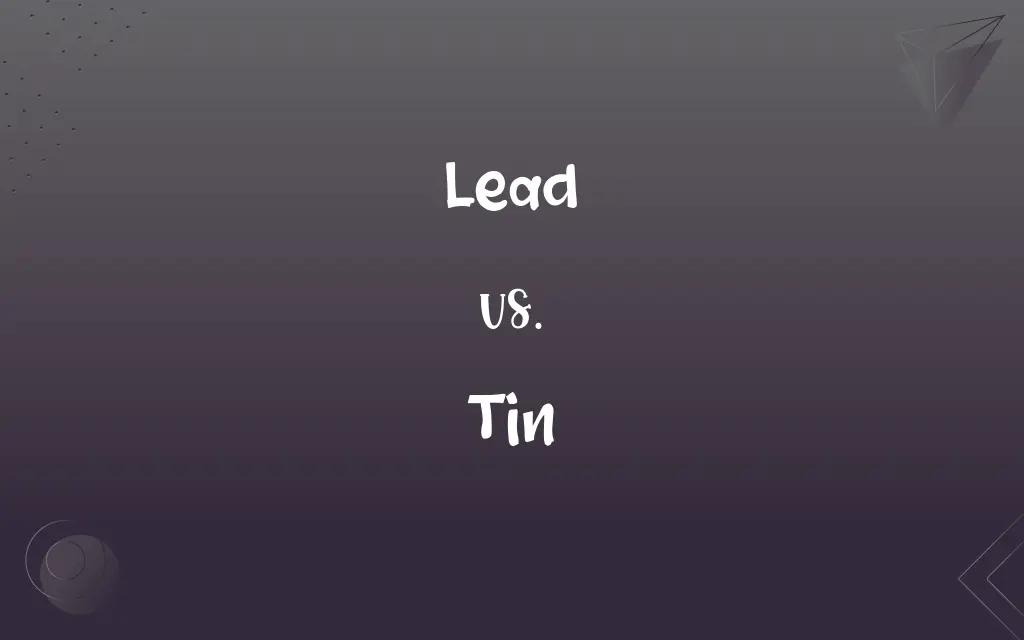Lead vs. Tin: What's the Difference?
Edited by Aimie Carlson || By Harlon Moss || Published on December 28, 2023
Lead is a dense, soft, heavy metal with symbol Pb, while tin is a malleable, silvery-white metal with symbol Sn.

Key Differences
Lead, with the atomic symbol Pb, is a heavy, malleable metal known for its high density and resistance to corrosion. Tin, symbolized as Sn, is lighter, less dense, and boasts a silvery-white appearance, often used for coating other metals.
Historically, lead has been used for centuries in construction and piping, known for its durability. Tin, in contrast, has been widely used in tin plating and as a component of various alloys, like bronze.
Lead is toxic and can cause health issues if ingested or inhaled, leading to its reduced use in modern applications. Tin, however, is less toxic and is used in food containers, electronics, and as solder.
From a chemical standpoint, lead is more reactive with acids and has a higher atomic number (82) compared to tin, which has an atomic number of 50 and is less chemically reactive.
In terms of applications, lead is utilized in batteries, radiation shields, and weights, while tin is prominent in soldering, tin foil, and as a protective coating for other metals.
ADVERTISEMENT
Comparison Chart
Symbol
Pb
Sn
Density
Higher
Lower
Toxicity
More toxic
Less toxic
Common Uses
Batteries, shields
Soldering, coatings
Historical Usage
Piping, construction
Tin plating, alloys
ADVERTISEMENT
Lead and Tin Definitions
Lead
The first or foremost position.
He took the lead in the race.
Tin
A silvery-white metal with the symbol Sn.
Tin is used for coating steel cans.
Lead
To guide or direct others.
She will lead the team in the upcoming project.
Tin
To cover or coat with tin.
They tin the copper wires for better conductivity.
Lead
To be the cause or reason for something.
His dedication led to his success.
Tin
Thin sheet of tinplate.
He wrapped the food in tin foil.
Lead
A position of advantage in a competition.
The team maintained their lead till the end.
Tin
A container made of tinplate.
She stored the cookies in a tin.
Lead
An element with the symbol Pb.
Lead is used in batteries.
Tin
An alloy containing tin.
Bronze is an alloy of copper and tin.
Lead
To show the way to by going in advance
The host led us to our table.
Lead
To guide or direct in a course
Lead a horse by the halter.
FAQs
What is lead primarily used for?
Lead is often used in batteries, radiation shielding, and as weights.
What is the chemical symbol for lead?
The chemical symbol for lead is Pb.
Is lead still used in plumbing?
Lead has been largely phased out in plumbing due to its toxicity.
Is lead toxic?
Yes, lead is toxic and can cause serious health issues.
Can lead be found in nature?
Yes, lead is a naturally occurring element.
What is tin primarily used for?
Tin is used in soldering, coatings, and tinplate for cans.
Are there safe levels of lead exposure?
No level of lead exposure is considered completely safe.
Is tin used in electronics?
Yes, tin is commonly used in solder for electronic components.
Is tin toxic?
Tin is less toxic compared to lead and is generally considered safe for most uses.
How is lead recycled?
Lead is recycled primarily from lead-acid batteries.
How is tin extracted?
Tin is extracted from its ore, mostly from the mineral cassiterite.
What are the health effects of tin exposure?
In general, tin exposure is not harmful, but certain tin compounds can be toxic.
What is the chemical symbol for tin?
The chemical symbol for tin is Sn.
What are the environmental impacts of lead?
Lead can be harmful to the environment, particularly to water sources and soil.
What is the difference in melting points between lead and tin?
Lead has a higher melting point compared to tin.
Is lead recyclable?
Yes, lead is highly recyclable.
Can tin be found in nature?
Yes, tin is a naturally occurring element.
What products contain tin?
Tin is found in food containers, electronics, and as part of various alloys.
Does tin corrode easily?
Tin is relatively resistant to corrosion, which makes it suitable for coatings.
Can tin be alloyed with other metals?
Yes, tin is commonly alloyed with copper to make bronze.
About Author
Written by
Harlon MossHarlon is a seasoned quality moderator and accomplished content writer for Difference Wiki. An alumnus of the prestigious University of California, he earned his degree in Computer Science. Leveraging his academic background, Harlon brings a meticulous and informed perspective to his work, ensuring content accuracy and excellence.
Edited by
Aimie CarlsonAimie Carlson, holding a master's degree in English literature, is a fervent English language enthusiast. She lends her writing talents to Difference Wiki, a prominent website that specializes in comparisons, offering readers insightful analyses that both captivate and inform.






































































